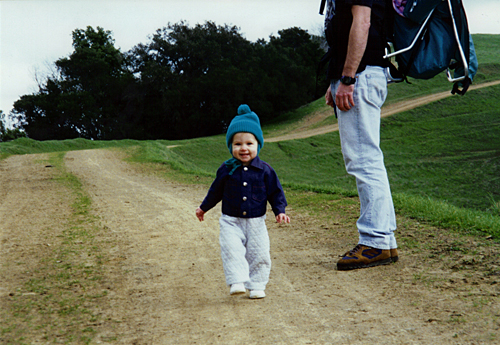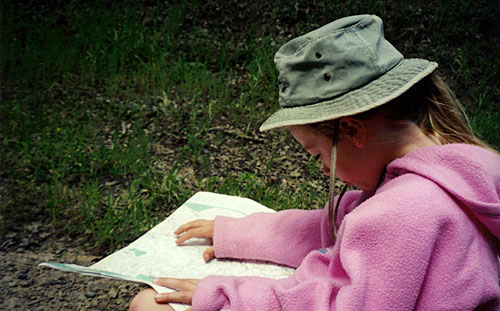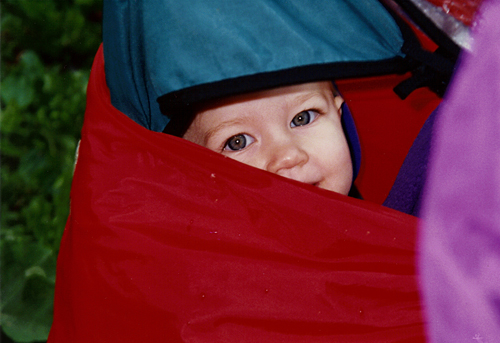How many miles should you backpack with a toddler or preschooler?
As many miles as the child wants to walk. And that’s probably a lot farther than most parents would think.

Kids as young as 2 years old are capable of hiking and running short distances on the trail, as long as Dad or Mom is ready with the carrier. (Photo: Barbara Egbert)
There’s a period of time — from roughly age 2 to 5 — when a child is no longer willing to be carried for an entire trip, but isn’t capable of walking the entire distance, either. That’s the time many parents give up even on day hikes with their children.
It’s easy to see why. The constant stops and starts, the frequent potty breaks, the desire to chase every butterfly and catch every lizard, the clamoring for water and snacks and — let’s face it — the whining are enough to make any parent think twice about something as ambitious as a backpacking trip. If the child is being carried, he wants to walk. As soon as he’s walked for half a mile, he wants to be carried. Who needs it?
We need it.
We as families need to get out in nature as often as possible. My husband, daughter, and I are happiest when we’re walking the long miles, identifying flowers, pointing out birds, finding our route on a map.
Our children need to learn how to entertain themselves without electronics and how to develop skills and confidence in an unstructured, natural way. And they need to get as much exercise as they can while they are still growing and before they discover instant messaging and social network sites.
We as parents need to draw on our infinite wells of patience and remember that getting to our campsite isn’t nearly as important as bringing along our children, so that backpacking becomes a shared activity full of wonderful memories. Remember, it won’t last forever — neither the good parts nor the bad parts.
My husband and I found a way to keep hiking and backpacking all through the preschool years, although it was often a struggle. As a result, by the time our daughter was 5 years old she could hike 10 or 12 miles a day, and was comfortable playing in camp and sleeping in a tent. She could recognize a rattlesnake and knew how to avoid poison oak. And was she ever a strong hiker!
Yes, preschool-age children can go on backpacking trips. But parents need to make a lot of adjustments. Here are some things to keep in mind.
-
Children seem to have two speeds: run and stop. It’s much harder for them to walk at a steady pace than it is to run hard and then rest, run hard and rest … over and over. Naturally, you don’t want your child running out of sight, but recognize that the steady pace that works for adults is actually more tiring for kids than bursts of energy. If possible, let them run on a short distance and then wait for you, or run back to you.

Teach kids who backpack and hike useful skills, like how to read a topo map, as Mary does during a backpacking trip with her dad to Henry Coe State Park in northern California.
(Photo: Gary Chambers) - Preschoolers typically are very inquisitive and want to help out, so this is a great age to introduce new experiences and skills. Let them help you pack the gear, read the map, look for trail signs, see which direction the compass needle points, set up the tent, listen for and identify birds. Introducing basic outdoor skills at this age will set the groundwork for an outdoors life.
- Kids often don’t recognize when they’re dehydrated. A child who is tired and cranky early in the day is probably primarily thirsty and hungry. Frequent water breaks are mandatory. Having his or her own water bottle or getting to share Mom and Dad’s can be a treat for a small child.
- Offer favorite snacks frequently. I kept my pockets full of Jolly Rancher hard candy to lure Mary along when we had to keep walking. Before heading out, let preschoolers help choose some of the menu items, from Mom or Dad's pre-selections.
- Kids don’t necessarily realize it when they have blisters. Wear proper-fitting, wicking socks — wool or synthetic, not cotton. Check kids’ feet before you start out — make sure socks aren’t bunched up and that shoelaces and tongues are all in their proper places.
-
Use day hikes to discover just how far your child can walk. If your child can probably walk the entire distance, but you can’t be sure, use the carrier as a backpack (stuffed with gear), and have another adult prepared to carry the extra gear in case the little one needs to be carried the last mile or two into camp. I knew Mary was ready to leave the carrier behind for good late one afternoon as we were hiking off-trail to Moose Lake in Sequoia National Park. She got bored, grabbed my ponytail and gave it a hard yank just to see what would happen. After that, she walked everywhere.

At 18 months, even a toddler who walks well will be carried much of the time in a baby backpack. But, be prepared to let small walkers in and out of the carrier regularly for exercise and to relieve boredom, and adjust your mileage accordingly.
(Photo: Gary Chambers) - Encourage, but don’t force, your child to walk farther on each outing. Even adults have off days. Be ready to stop if your child is having one. Plan trips with close, intermediate, and distant options for campsites with water.
- When possible, plan a backpacking route that gets the uphill part out of the way early, so that later, when the child is tiring, it’s mostly downhill and the child will be much more likely to walk the remaining distance.
- No matter how strong and confident, a 4-year-old is still a 4-year-old. Some parents disagree on this point, but we always allowed — in fact, encouraged — our daughter to bring along a stuffed animal. Mary’s “animal friend” provided her with something cuddly to sleep with, and also a playmate who could be dressed up with bandanas and hair bands, and could take a starring role in campsite theaters made of rocks, twigs, and pinecones. Small drawing pads and pencils are also good for backcountry entertainment.
- Allow, but don’t require, your child to carry his own pack and gear. Most kids really want to carry a pack, but a stuffed animal and a small bottle of water are a sufficient load at first.
- Create some family traditions that only happen on backpacking trips. For example, once I had breakfast ready in the morning, Mary and her dad would climb a tree and eat their Pop-Tarts up there. It helped get Mary up and moving if she knew there was a cup of cocoa and a tree waiting for her, and we only eat Pop-Tarts on backpacking trips.
- Be ready to sing lots of songs, recite lots of old jokes, and tell lots of stories. You don’t have to be Hemingway, but do make an effort. Take a quick look through a book of fairy tales the night before a backpacking trip, and you’ll be ready to keep a small child entertained. For older kids, help them make up their own stories about the animals who live in the woods and the people who used to share the wilderness with them. I had an entire cast of characters, ranging from a pair of firefighters who owned a ranch to a selection of talking animals who played tricks on backpackers. I would encourage Mary to help with the plot, and that helped keep her engaged.
- Usually it’s the parent entertaining the child with stories and songs, but a child who is taught to really observe will soon begin entertaining the parents. I remember one hot, humid day in Maryland with Mary in the carrier and me struggling uphill. Mary started pointing out the beauty of the mountain laurel blooms all around us, which lightened my mood considerably.
- Be prepared for things to go wrong. Then, when they do go wrong, you can fix them in such a way that (a) your trip isn’t ruined, (b) nobody refuses to ever go backpacking again, and (c) your kids think you are the COOLEST parent ever! For example, give some thought to the exact contents of your first aid kit, including how you’ll remove ticks and soothe bug bites.
Having a child along on a backpacking trip is a wonderful experience. They see things adults don’t see, appreciate experiences that adults have grown accustomed to, and have fun in ways that their parents have forgotten. The extra trouble is well worth it.
Barbara Egbert has been backpacking, with and without a child, since 1988. In 2004, Barbara, husband Gary, and then 10-year-old daughter Mary hiked the 2,650-mile Pacific Crest Trail. Visit Barbara at www.PCTfamily.com.
This article is the second in a four-part series on backpacking with children of different ages.
Part 1: Backpacking with Baby
Part 2: Backpacking with a Toddler or Preschooler
Part 3: Backpacking with a Grade-Schooler
Part 4: Backpacking with a Teen

 by Barbara Egbert
by Barbara Egbert









